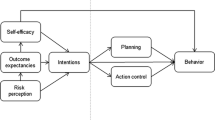Abstract
Undergraduate volunteer smokers (final N =36)were assigned to four experimental groups: (1)self-monitoring control; (2)covert modeling; (3)covert modeling with high value-high rate overt consequation of between-session rehearsals of covert modeling scenes; and (4)covert modeling with low value-low rate overt consequation of rehearsals. All groups self-monitored smoking frequency, urge frequency, and urge intensity throughout the duration of the 4-week experiment and during the 1-month follow-up. A variety of checks indicated that the experimental manipulations were adequately implemented. All experimental groups except covert modeling alone, which failed to exhibit changes across time, produced the typical V-shaped reduction in smoking frequency that has been found with most smoking reduction programs. The other research questions, possible enhancement of covert modeling by overt motivational or signaling consequences, therefore remained unanswered in the present study.
Similar content being viewed by others
Reference Notes
Cautela, J. R.Covert modeling. Paper presented at the meeting of the Association for Advancement of Behavior Therapy, Washington, D.C., September 1971.
Rutner, I. T.The modification of smoking behavior through techniques of self-control. Unpublished master's thesis, Wichita State University, 1967.
Danaher, B. G., & Lichtenstein, E.An experimental analysis of coverant control: Cueing and consequation. Paper presented at the meeting of the Western Psychological Association, San Francisco, April 1974.
References
Bandura, A. Self-reinforcement: Theoretical and methodological considerations.Behaviorism 1976,4 135–155.
Best, J. A., & Steffy, R. A. Smoking modification procedures tailored to subject characteristics.Behavior Therapy 1971,2 177–191.
Catania, A. C. The myth of self-reinforcement.Behaviorism 1975,3 192–199.
Catania, A. C. Self-reinforcement revisited.Behaviorism 1976,4 157–162.
Cautela, J. R., Flannery, R. B., & Hanley, S. Covert modeling: An experimental test.Behavior Therapy 1974,5 494–502.
Hay, W. M., Hay, L. R., & Nelson, R. O. The adaptation of covert modeling procedures to the treatment of chronic alcoholism and obsessive-compulsive behavior: Two case reports.Behavior Therapy 1977,8 70–76.
Kanfer, F. H. Self-management methods. In F. H. Kanfer & A. P. Goldstein (Eds.),Helping people change. New York: Pergamon, 1975.
Kazdin, A. E. Covert modeling and the reduction of avoidance behavior.Journal of Abnormal Psychology 1973,81 87–95.
Kazdin, A. E. Comparative effects of some variations of covert modeling.Journal of Behavior Therapy and Experimental Psychiatry 1974,5 225–231. (a)
Kazdin, A. E. Covert modeling, model similarity and reduction of avoidance behavior.Behavior Therapy 1974,5 325–340. (b)
Kazdin, A. E. The effect of model identity and fear-relevant similarity on covert modeling.Behavior Therapy 1974,5 624–635. (c)
Kazdin, A. E. Effects of covert modeling and model reinforcement on assertive behavior.Journal of Abnormal Psychology 1974,83 240–252. (d)
Kazdin, A. E. Covert modeling, imagery assessment and assertive behavior.Journal of Consulting and Clinical Psychology 1975,43 716–724.
Kazdin, A. E. Assessment of imagery during covert modeling of assertive behavior.Journal of Behavior Therapy and Experimental Psychiatry 1976,7 213–219. (a)
Kazdin, A. E. Effects of covert modeling, multiple models, and model reinforcement on assertive behavior.Behavior Therapy 1976,7 211–222. (b)
Keutzer, C. S. Behavior modification of smoking: The experimental investigation of diverse techniques.Behaviour Research and Therapy 1968,6 137–157.
Lichtenstein, E., & Danaher, B. G. Modification of smoking behavior: A critical analysis of theory, research, and practice. In M. Hersen, R. M. Eisler & P. M. Miller (Eds.),Progress in behavior modification (Vol. 3). New York: Academic, 1976.
McFall, R. M., & Hammen, C. L. Motivation, structure, and self-monitoring: The role of non-specific factors in smoking reduction.Journal of Consulting and Clinical Psychology 1971,37 80–86.
Rachlin, H. Self-control.Behaviorism 1974,2 94–107.
Yates, A. J.Theory and practice in behavior therapy. New York: Wiley, 1975.
Author information
Authors and Affiliations
Rights and permissions
About this article
Cite this article
Nesse, M., Nelson, R.O. Variations of covert modeling on cigarette smoking. Cogn Ther Res 1, 343–353 (1977). https://doi.org/10.1007/BF01663998
Issue Date:
DOI: https://doi.org/10.1007/BF01663998




